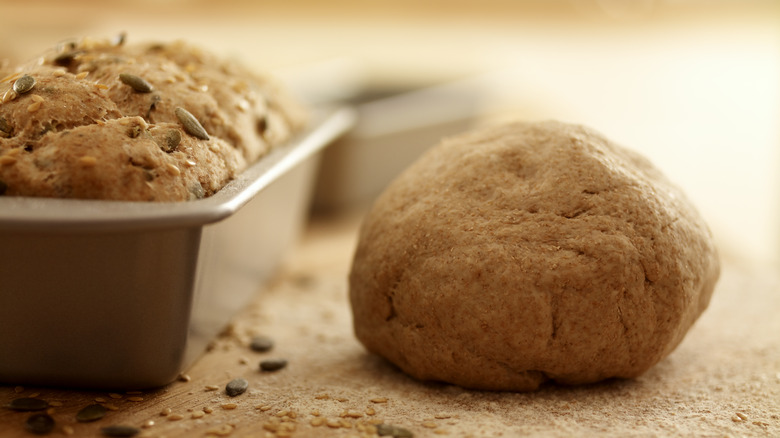You Should Think Twice Before Greasing Your Bread Loaf Tin With Butter
There's an old saying that baking is a science, and it's absolutely true. You might be able to get away with adding a bit of this and that to a stew, some extra ingredients to a chili, or experimenting with a burger seasoning you invented in the moment, but when it comes to breads, that's just not going to work. There are a ton of bread baking hacks that you should know, and many of them — like weighing your ingredients — involve getting things precisely right. That doesn't just apply to the recipe itself, and it also extends to something that many home bakers might not think twice about: greasing your loaf pan.
There are a number of options that you might just accept as your go-to, with butter being at the top of your list. If that sounds familiar, you might want to rethink this. Why? Using butter to grease your bread loaf tins might actually make your loaf stick more, and that's the opposite of what you're trying to do.
What's going on here? Butter has a relatively high water content, with most types of butter being around 16 or 17% water. While some recipes might call specifically for using butter, those that don't — particularly quick breads like a classic zucchini bread or a traditional cornbread — can be absolutely destroyed when the water content in butter causes the delicate underside of your bread to stick. Fortunately, there are better options.
Reach for the shortening, and less is best
In many cases, quick bread recipes will specify what's going to work best to grease the pan — and that's usually going to be either shortening or a non-stick cooking spray. While it might seem logical that a heavy, thick coat of either is going to work the best, it's actually true that less is best.
For solids like shortening, you can opt for melting them first and painting on a thin, even coat of grease with a kitchen brush. (If the recipe calls for using butter, you can also melt butter and use the same method.) Or you can let your shortening sit at room temperature for a while — that'll make it easier to get that thin coating. It's also worth noting that in many cases, you're only going to want to grease the bottom of the pan, the corners, and the very bottom ½-inch or so of the sides. Why? It'll help your bread rise.
Now, there's one more option that's worth mentioning. If you regularly find yourself having problems with bread sticking to the pan, consider not using a pan at all. While that's not going to work with some quick breads — like pumpkin bread — others have dough that is firm enough to stand up on its own. Shape the dough and bake it on a cookie sheet covered with parchment paper or cooking spray. While it won't have the same loaf shape, it could be your new go-to method.

